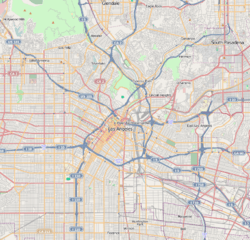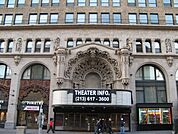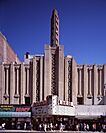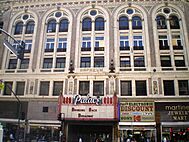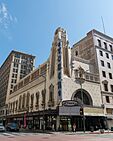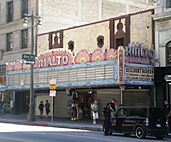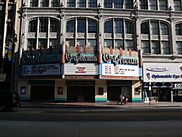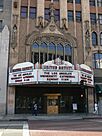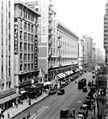Broadway Theater District (Los Angeles) facts for kids
Quick facts for kids |
|
|
Broadway Theater District
|
|
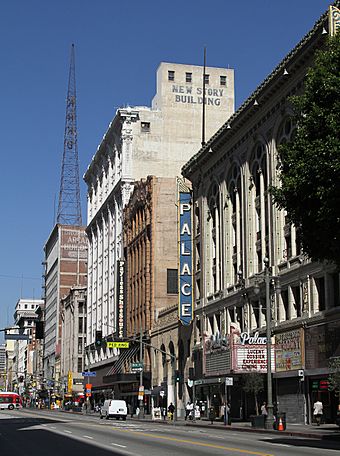
A look down the street in the Broadway Theater District
|
|
| Location | 300—933 S. Broadway, Los Angeles, California |
|---|---|
| Architect | Multiple |
| Architectural style | Early Commercial, Late 19th And 20th Century Revivals, Art Deco |
| NRHP reference No. | 79000484 |
| Added to NRHP | May 9, 1979 |
The Broadway Theater District in Downtown Los Angeles is a famous street with twelve amazing historic theaters. It's the first and largest theater district to be listed on the National Register of Historic Places (NRHP), which is a list of special places in the United States that are worth protecting.
These theaters, often called "movie palaces," are all located along a six-block stretch of Broadway. This makes it the only place left in the U.S. with so many of these grand, old theaters packed together. Besides theaters, this area was also a busy shopping hub in the early 20th century, filled with department stores.
Contents
What Makes This District Special?
The Broadway Theater District is a unique part of Los Angeles. It runs along South Broadway from Third Street to Ninth Street. The twelve movie theaters in this area were all built between 1910 and 1931.
Imagine a street lined with giant, fancy buildings, each one a theater with bright neon signs. That's what Broadway looked like in its golden age. A writer for the Los Angeles Times once called it "the only large concentration of vintage movie theaters left in America."
A Trip Back in Time
The Golden Age of Broadway
The first theater in the district opened in 1910. By 1931, this street had more movie theaters in one place than anywhere else in the world. Together, they could seat over 15,000 people!
At that time, Broadway was the center of entertainment in Los Angeles. It was the place to be, where famous movie stars and everyday people came to watch the latest Hollywood films. One newspaper described it as a time when the streets were "awash in neon" and thousands of people filled the theaters every night. Before World War II, downtown L.A. was truly the movie capital of the world.
A writer named Jack Smith, who grew up nearby, remembered spending his Saturdays at these theaters. He said walking into the beautiful buildings felt like entering a dream world, a wonderful escape from real life.
Big Changes for the Theaters
After World War II, things started to change. People began moving to the suburbs and watching movies in newer theaters closer to their homes. The grand theaters on Broadway weren't as popular with the same crowds anymore.
Many of the theaters started showing Spanish-language movies and live shows. This brought a new audience to the district and helped keep the theaters open. In fact, the Los Angeles Times said in 1988 that this "Latino renaissance" saved Broadway from being forgotten.
Saving the Historic Theaters
Since the 1980s, people have worked hard to save and restore these beautiful old theaters. A group called the Los Angeles Conservancy started a summer program called "Last Remaining Seats." They would open the old movie palaces to show classic Hollywood movies, giving people a chance to see them on the big screen.
Many people loved the program. Some were older and felt nostalgic, while others had never seen a movie in a theater with a fancy balcony before. One person wrote about the experience, saying it was like being "transported to a world of powdered wigs and hoop skirts, a rococo fantasy of gilded cherubs and crystal chandeliers. And then the film started."
Even with these efforts, keeping the theaters open has been a challenge. Some have been turned into stores or churches. But in 2008, the City of Los Angeles started a project called "Bringing Back Broadway" to help revitalize the area and its historic theaters.
The Twelve Famous Theaters
Here are the twelve historic theaters that make up the Broadway Theater District:
- Million Dollar: Opened in 1918, this was one of the first grand movie palaces in the area.
- Roxie: Opened in 1932 with a cool Zigzag Moderne design.
- Cameo: One of the oldest, opening in 1910 as a nickelodeon (an early type of movie theater).
- Arcade: Opened in 1910 for live shows and later showed movies.
- Los Angeles: Opened in 1931, this theater is known for its incredibly fancy French Baroque style.
- Palace: Opened in 1911, it was originally part of the famous Orpheum circuit for live vaudeville shows.
- State: A large theater that opened in 1921 and could seat almost 2,500 people.
- Globe: Opened in 1913 for plays, it later showed movies and is now used for events.
- Tower: Opened in 1927, it was the first theater in Los Angeles designed to show "talkies" (movies with sound).
- Rialto: Opened in 1917, it was once owned by the famous movie showman Sid Grauman.
- Orpheum: Opened in 1926, this beautiful theater still hosts concerts and events today.
- United Artists: Opened in 1927 by the movie studio United Artists. The building now includes a hotel.
Other Historic Theaters Nearby
Besides the main twelve, there are other historic theaters just a short walk from Broadway.
- Regent: Opened in 1914, it is now a popular concert venue.
- Warner Bros. Downtown: Opened in 1920, it was a huge movie palace that was later bought by Warner Brothers.
- Mayan: Opened in 1927, this theater has a unique and detailed design inspired by ancient Mayan art. It's now a nightclub.
- Belasco: Opened in 1926 right next to the Mayan, it is now a concert hall.
Images for kids
See also
- List of Registered Historic Places in Los Angeles
- Broadway (Los Angeles) - commercial and other buildings contributing to the historic districts
- Central Business District, Los Angeles (1880-1899) - business district of Los Angeles north of 3rd Street before it moved south along Broadway


